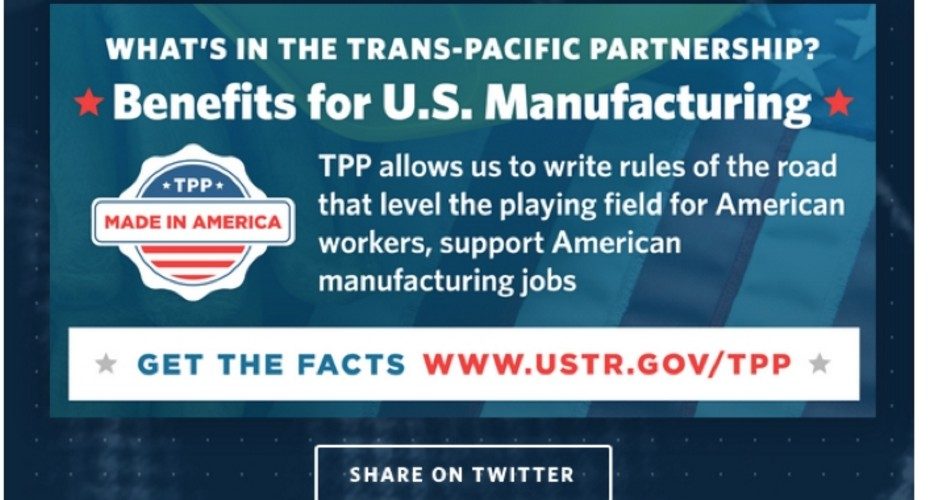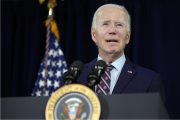
The Trans-Pacific Partnership (TPP) agreement is not “free trade” in the classic sense, nor is it even much about trade. It is about creating new institutions of global governance. The TPP is an assault on U.S. national sovereignty, as its objective is to create a European Union-style Pacific Union. And much like how the EU’s executive body is the European Commission, the TPP will also have an executive body known as the Trans-Pacific Partnership Commission or TPP Commission.
From examining the text, here is what we know so far from the actual TPP Agreement, which was formally released to the public on the website of the U.S. Trade Representative (USTR) on November 5, a full month after U.S. Trade Representative Michael Froman announced that the United States and the 11 other participating Pacific Rim nations had reached a final agreement:
The TPP recognizes the authority of the World Trade Organization (WTO)
Toward the beginning of the preamble of the TPP Agreement, it states that TPP parties resolve to: “BUILD on their respective rights and obligations under the Marrakesh Agreement Establishing the World Trade Organization.” (Italics in original). Furthermore, chapter 8 of the TPP agreement makes numerous references to the World Trade Organization (WTO) and its various safeguards and agreements such as the TBT Agreement, which is the WTO Agreement on Technical Barriers to Trade. As an example, subsection 1 of Article 8.4, revealingly entitled “Incorporation of Certain Provisions of the TBT Agreement,” lists the various provisions of the TBT Agreement that are to be “incorporated into and made part” of the TPP Agreement.
In addition, subsection 1 of Article 8.5, entitled “International Standards, Guides and Recommendations,” states, “The Parties acknowledge the important role that international standards, guides and recommendations can play in supporting greater regulatory alignment, good regulatory practice and reducing unnecessary barriers to trade.” (Emphasis added).
Leave it to globalists to offer nations a reduction of “unnecessary barriers to trade” by selling them the idea of recognizing “the important role that international standards, guides and recommendations can play in supporting greater regulatory alignment.” In other words, in order to reduce trade barriers and have “free trade” we need “international standards” and guidelines that promote “greater regulatory alignment,” i.e. more global governance. Subsection 2 of Article 8.5 of the TPP Agreement further identifies the “international standards” as the WTO’s TBT Agreement.
TPP is the precursor to the larger Free Trade Area of the Asia-Pacific (FTAAP)
Despite claims by major media organs such as the Wall Street Journal and Fox News, and neoconservative advocacy groups such as the American Action Network, the TPP is not intended to counter China’s influence in the Asia-Pacific region. Instead, “The TPP is regarded as an interim arrangement or stepping stone toward a broader, regionwide Free Trade Area of the Asia Pacific (FTAAP),” according to the Peterson Institute for International Economics (PIIE). (Emphasis added.) The FTAAP is a proposed regional “free trade” agreement that would include all 21 Asia-Pacific Economic Cooperation (APEC) countries, including China and Russia. The TPP’s role relative to facilitating the future FTAAP is further verified within the TPP Agreement. The final point on the bottom of the second page of the two-page TPP preamble reads:
EXPAND their partnership by encouraging the accession of other States or separate customs territories in order to further enhance regional economic integration and create the foundation of a Free Trade Area of the Asia Pacific. [Bold in original.]
The TPP Agreement plainly states that accession to the TPP is open to “any State … that is a member of APEC,” which would include the aforementioned APEC member states of Communist China and Russia. The same clause of the agreement makes it possible for the TPP to expand and serve as the “foundation of a Free Trade Area of the Asia Pacific,” as stated earlier in the preamble.
Chapter 8 of the TPP agreement encourages TPP members to “implement the APEC Mutual Recognition Arrangement for Conformity Assessment of Telecommunications Equipment (MRATEL) and the APEC Mutual Recognition Arrangement for Equivalence of Technical Requirements (MRA-ETR) with respect to each other or other arrangements to facilitate trade in telecommunications equipment.” Furthermore, chapter 30 of the TPP Agreement, entitled “Final Provisions,” opens TPP membership to APEC members. Article 30.4, in chapter 30, of the TPP reads:
Article 30.4: Accession
1. This Agreement is open to accession by:
(a) any State or separate customs territory that is a member of APEC, and
(b) such other State or separate customs territory as the Parties may agree, that is prepared to comply with the obligations set out in the Agreement, subject to such terms and conditions as may be agreed between the State or customs territory and the Parties, and following approval in accordance with the applicable legal procedures of each Party and acceding State or customs territory.
TPP abrogates U.S. sovereignty to an executive “Commission” analogous to that of the European Union
Since before the public release of the text of the TPP Agreement, Senator Jeff Sessions (R-Ala.), who had previously entered the secret reading room in Congress where the TPP Agreement was kept, warned about the creation of a TPP Commission, which he has described as being “extremely broad” and having “the hallmarks of a nascent European Union.” Following the release of the TPP Agreement, Sessions further described the TPP Commission as “a Pacific Union — which meets, appoints unelected bureaucrats, adopts rules, and changes the agreement after adoption.”
Sessions was referring to chapter 27 of the TPP, entitled “Administrative and Institutional Provisions,” which establishes and outlines the functions of the TPP Commission. Article 27, section 1, of the TPP plainly states: “The Parties hereby establish a Trans-Pacific Partnership Commission (Commission) which shall meet at the level of Ministers or senior officials, as mutually determined by the Parties. Each Party shall be responsible for the composition of its delegation.” Article 27, section 2, outlines the various functions and powers of the TPP Commission as follows:
The Commission shall:
(a) consider any matter relating to the implementation or operation of this Agreement;
(b) review within 3 years of entry into force of this Agreement and at least every 5 years thereafter the economic relationship and partnership among the Parties;
(c) consider any proposal to amend or modify this Agreement;
(d) supervise the work of all committees and working groups established under this Agreement;
(e) establish the Model Rules of Procedure for Arbitral Tribunals referred to in Article 28.11.2 and Article 28.12, and, where appropriate, amend such Model Rules of Procedure for Arbitral Tribunals;
(f) consider ways to further enhance trade and investment between the Parties;
(g) review the roster of panel chairs established under Article 28.10 every 3 years, and when appropriate, constitute a new roster; and
(h) determine whether the Agreement may enter into force for an original signatory notifying pursuant to paragraph 4 of Article 30.5.1 (Entry into Force).
On November 5, 2015, in a press release, Senator Session called these powers of the TPP Commission “open-ended.” Citing The TPP Commission’s broad authority over the creation of new rules and procedures, global migration, and global environmental standards, Sessions said:
This global governance authority is open-ended: “The Commission and any subsidiary body established under this Agreement may establish rules of procedures for the conduct of its work.” It covers everything from the movement of foreign nationals: ‘No Party shall adopt or maintain … measures that impose limitations on the total number of natural persons that may be employed in a particular service sector … in the form of numerical quotas or the requirement of an economic needs test”; to climate regulation: “The Parties acknowledge that transition to a low emissions economy requires collective action.”
Furthermore, the TPP Commission is also tasked with approving the accession of new states or separate customs territories to the TPP, according to Article 30.4 of the TPP Agreement. Congress will not have a say as to whether or not to approve or block new states attempting to join the TPP; the power and decision of accession resides solely with the TPP Commission.
With all this in mind, it would behoove congressional lawmakers to avail themselves of the aforementioned facts prior to casting their votes on the TPP Agreement. At the very least, this information should cause grave concern to anyone wishing to preserve America’s national sovereignty and independence. Congress may vote on the TPP as early as the first week in March.
Related articles:
Undeniable: TPP Is Foundation for FTAAP
APEC Summit Reaffirms Commitment to FTAAP Through TPP
Secret TPP Text Released: GOP to Push Obama’s Dangerous Trade Deal
Secretary John Kerry Invites Russia and China into TPP
10 Reasons Why You Should Oppose TPP and TTIP
“Living,” “Evolving” Dangers Are Hidden in ObamaTrade (TPP & TTIP)
Trans-Pacific Partnership To Facilitate U.S.-China Merger



